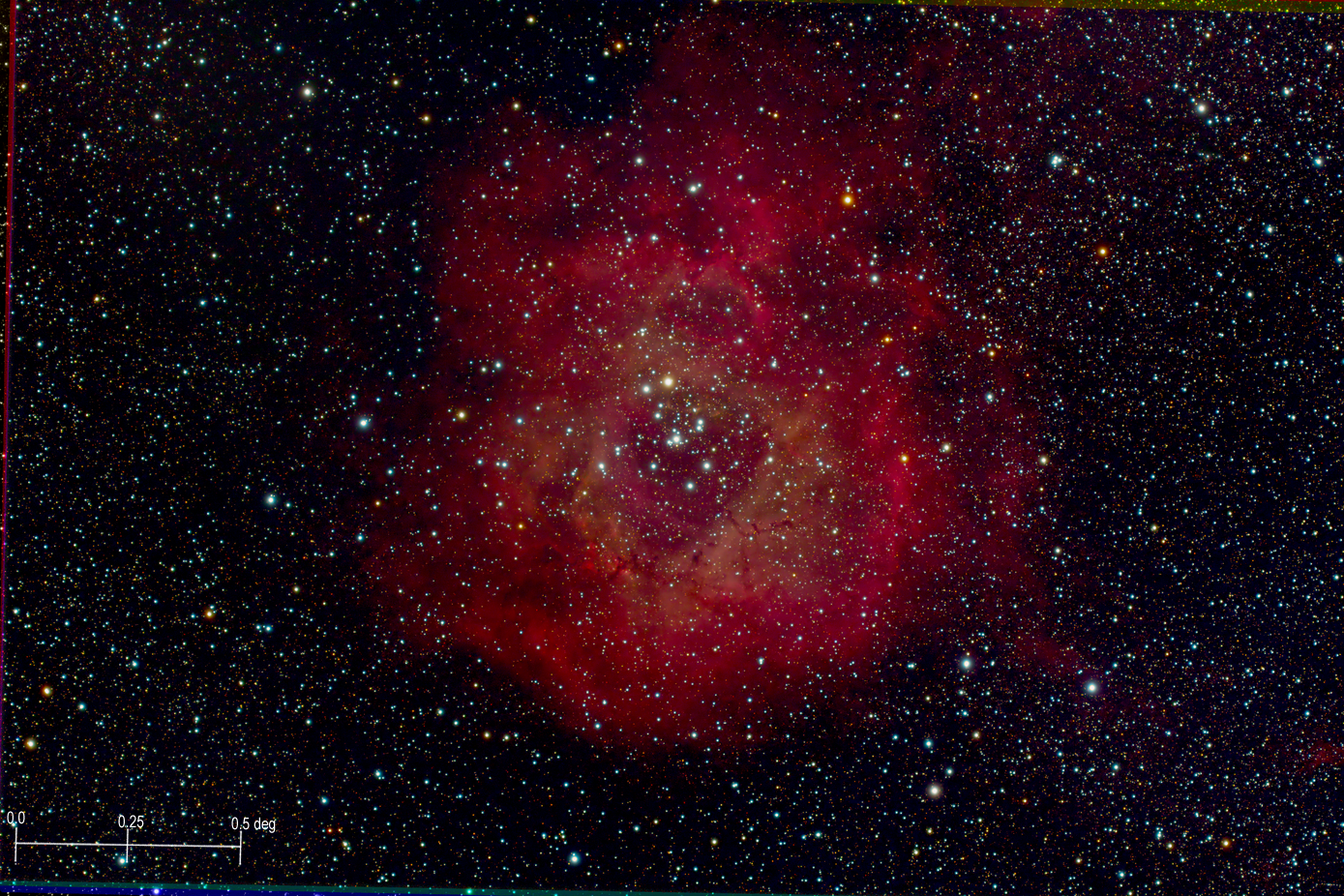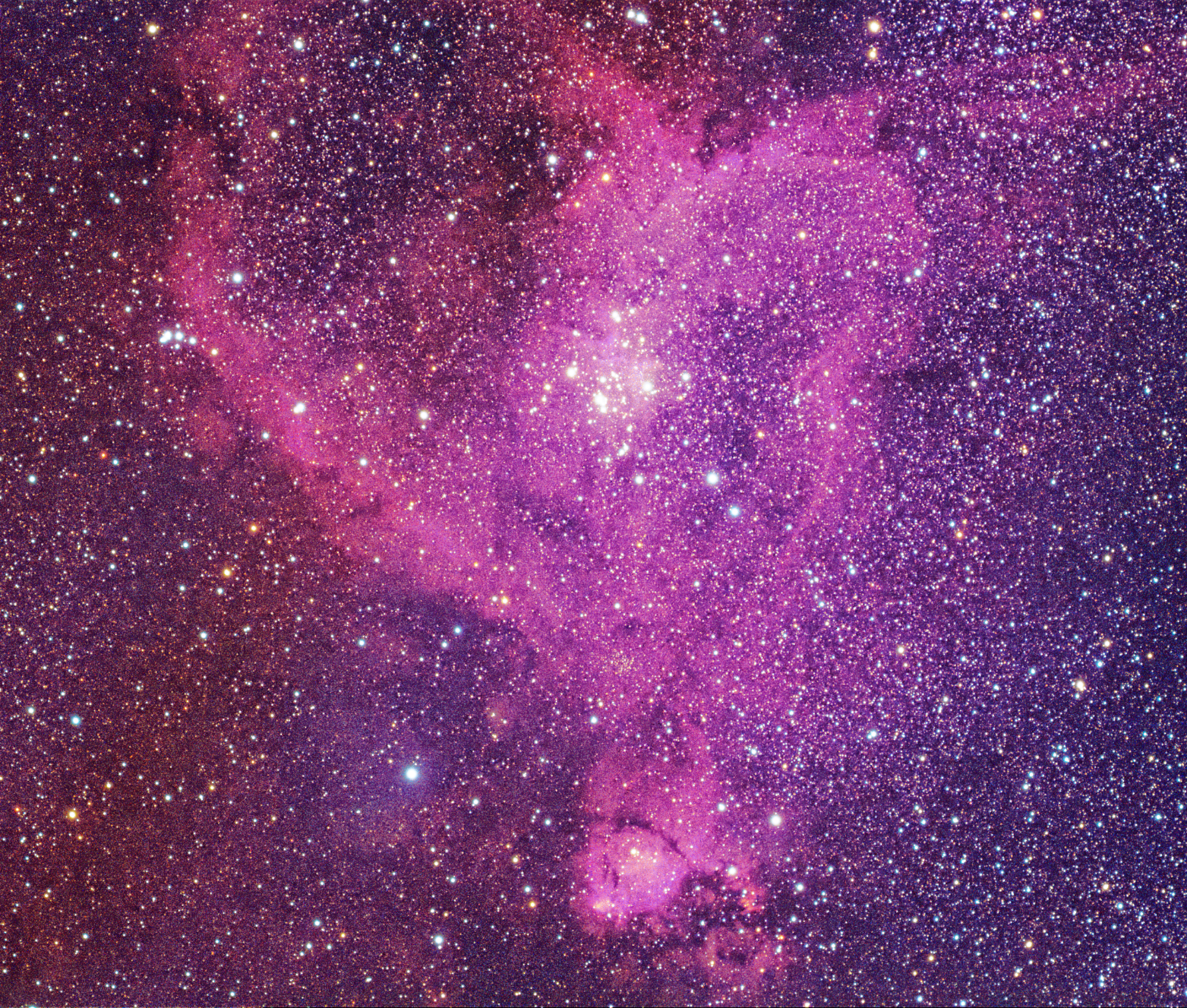𝐀𝐧𝐧𝐢𝐦𝐞 𝐖𝐨𝐧𝐠 on Nostr: Name: NGC 2244, NGC 2237 - The Rosette Nebula Constellation: Monoceros If you ever ...
Name: NGC 2244, NGC 2237 - The Rosette Nebula
Constellation: Monoceros
If you ever want to gauge the uselessness of government, just cast your gaze toward the Rosette Nebula.
Why? The Rosette Nebula was made the state astronomical object of Oklahoma in 2019. Why this object specifically? Likely, because the state flower is a rose. I believe it is also the only state with "state astronomical object". Passed that, the object has no associated with Oklahoma.
The star cluster in the middle was discovered by English astronomer John Flamsteed in 1690, about eighty years after the telescope was invented. A little over one hundred years later, the nebula itself was discovered by English astronomer... John Herschel! Finally, something not discovered by either Messier or William Herschel! Granted, it was his son, but still! (Incidentally, despite having the last name Herschel, none of the Herschel family was Jewish as far as I could tell. Their family was so firmly entrenched in astronomy that their Coat of arms was literally an observatory.)
Anyway.
Supposedly, making the Rosette the "State Object" was done to "promote stargazing tourism" to Oklahoma, especially in the panhandle. But the nearby state of New Mexico has just as dark skies that are also much clearer and less turbulent. It's not to say people don't go to Oklahoma for this reason, but I doubt the average guy would learn about the "state object" and then say to his spouse "Babe! We just gotta go to Oklahoma!"
It's disheartening that instead of advocating for additional dark sky sites within the state, or reducing light pollution within cities, efforts seem to be focused on highlighting the few areas only marginally affected by light pollution for tourism purposes. Maybe light pollution isn't going to end the world, but in some ways it's just as dramatic. While global warming enthusiasts squabble over a .001C temperature increases in the North Atlantic Ocean, you can compare your view of the night sky from your back yard to a camp site a hundred miles away. The contrast can't be denied, you can literally see the problem.
There's something sad that part of the natural world is hidden from us when we live near a city, and that instead of taking even the smallest baby steps to fix it, we promote the last few areas that are only partially impacted by it for tourism. We're commodifing it. But then again, could you convince the average person that there is a problem, or that it's worth fixing?
I can already see the guy, grumpy that a "bunch'a snowflakes" want him to turn off his porch light at night, and so he installs a 6000mw blue LED spotlight in his front yard.
Well, I guess I'll get off my soap box now.
Honestly, there's not really much to say about about the Rosette that I didn't say about the previous object. It's a large emission nebula, a big star forming region, etc, etc, etc... But it is a much more pretty object than the Heart Nebula, in my opinion. Also, Monoceros is probably the bougiest way to say "Unicorn".
Oh, and like I said with Thor's Helmet, the names of these nebula is very unofficial. The Rosette is also sometimes called the Skull Nebula. Can you see why?
I realized that in a lot of astronomy photos, it's hard to get a sense of scale for what you're looking at. To help with that, I'll probably start trying to add a little scale marker of .5 degrees, which is about the same as the apparent size of the sun and the moon. I also left some artifacts in from my processing method, showing somewhat how it was taken.
I guess the only thing left to say is that this is probably the first picture I've taken of a DSO (short for Deep Space Object) that I'm actually kind of proud of. I'm eager to take more with this new method, but it seems it's going to be cloudy for the next week, and with the full moon out now, I'm not going to get the chance.

Constellation: Monoceros
If you ever want to gauge the uselessness of government, just cast your gaze toward the Rosette Nebula.
Why? The Rosette Nebula was made the state astronomical object of Oklahoma in 2019. Why this object specifically? Likely, because the state flower is a rose. I believe it is also the only state with "state astronomical object". Passed that, the object has no associated with Oklahoma.
The star cluster in the middle was discovered by English astronomer John Flamsteed in 1690, about eighty years after the telescope was invented. A little over one hundred years later, the nebula itself was discovered by English astronomer... John Herschel! Finally, something not discovered by either Messier or William Herschel! Granted, it was his son, but still! (Incidentally, despite having the last name Herschel, none of the Herschel family was Jewish as far as I could tell. Their family was so firmly entrenched in astronomy that their Coat of arms was literally an observatory.)
Anyway.
Supposedly, making the Rosette the "State Object" was done to "promote stargazing tourism" to Oklahoma, especially in the panhandle. But the nearby state of New Mexico has just as dark skies that are also much clearer and less turbulent. It's not to say people don't go to Oklahoma for this reason, but I doubt the average guy would learn about the "state object" and then say to his spouse "Babe! We just gotta go to Oklahoma!"
It's disheartening that instead of advocating for additional dark sky sites within the state, or reducing light pollution within cities, efforts seem to be focused on highlighting the few areas only marginally affected by light pollution for tourism purposes. Maybe light pollution isn't going to end the world, but in some ways it's just as dramatic. While global warming enthusiasts squabble over a .001C temperature increases in the North Atlantic Ocean, you can compare your view of the night sky from your back yard to a camp site a hundred miles away. The contrast can't be denied, you can literally see the problem.
There's something sad that part of the natural world is hidden from us when we live near a city, and that instead of taking even the smallest baby steps to fix it, we promote the last few areas that are only partially impacted by it for tourism. We're commodifing it. But then again, could you convince the average person that there is a problem, or that it's worth fixing?
I can already see the guy, grumpy that a "bunch'a snowflakes" want him to turn off his porch light at night, and so he installs a 6000mw blue LED spotlight in his front yard.
Well, I guess I'll get off my soap box now.
Honestly, there's not really much to say about about the Rosette that I didn't say about the previous object. It's a large emission nebula, a big star forming region, etc, etc, etc... But it is a much more pretty object than the Heart Nebula, in my opinion. Also, Monoceros is probably the bougiest way to say "Unicorn".
Oh, and like I said with Thor's Helmet, the names of these nebula is very unofficial. The Rosette is also sometimes called the Skull Nebula. Can you see why?
I realized that in a lot of astronomy photos, it's hard to get a sense of scale for what you're looking at. To help with that, I'll probably start trying to add a little scale marker of .5 degrees, which is about the same as the apparent size of the sun and the moon. I also left some artifacts in from my processing method, showing somewhat how it was taken.
I guess the only thing left to say is that this is probably the first picture I've taken of a DSO (short for Deep Space Object) that I'm actually kind of proud of. I'm eager to take more with this new method, but it seems it's going to be cloudy for the next week, and with the full moon out now, I'm not going to get the chance.
quoting note1f00…c4laName: IC 1805 - The Heart Nebula
Constellation: Cassiopeia
Just in time for Valentines day!
The Heart nebula is located 7,500 ly away, in the southern part of Cassiopeia. It spans over 200 light-years across and is part of a larger star-forming region that also includes the neighboring Soul nebula (IC 1848) and the Fish Head nebula (IC1795) located at the tip of the Heart nebula (it doesn't look much like a fish to me). As is becoming a pattern with most of the objects so far, it was discovered by William Herschel in 1787. However, the structure is so large that many other parts of it were discovered by other astronomers throughout the years, meaning it has multiple designations in various catalogues which is very confusing. That said, unless you're using a large and fast telescope in a very dark area, I doubt you'll see the famous heart shape, or much else here (though it's always worth it to look).
Similar to the Horse Head Nebula and Thor's Helmet. it's an emission nebula, the heart shape is made up of ionized hydrogen that glows primarily in far end of human vision, 656nm, making it hard to see visually. However, there is also Oxygen III (500nm which is green), and Sulfur II emissions (672nm, also red). This can't be seen easily here, but using something called the Hubble palette really brings these colors out, but as a false color image filled with blues for hydrogen and yellows and greens for oxygen and sulfur.
As stated, this is also part of a star forming region. Where you have young stars, you'll have lots of blue O and A type stars. Their light is partially what's blowing away the dust, giving it a heart shape. But these stars are also so bright that illuminating much of this dust. The naturally red emission mixed with the white~blueish light from the young stars reflecting off the dust makes it look pinkish in natural color, really selling the heart shape.
note1r3l…u236


